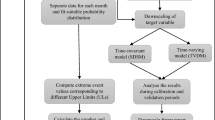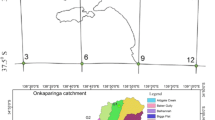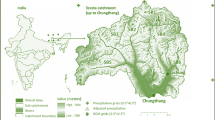Abstract
Statistical and dynamic downscaling approaches are commonly used to downscale large-scale climatic variables from global circulation (GCM) and regional circulation (RCM) model outputs to local precipitation. The performance of these two approaches may differ from each other for daily precipitation projections when applied in the same region. This is examined in this study based on the estimation of extreme precipitation. Daily precipitation series are generated from GCM HadCM3, CGCM3/T47 and RCM HadCM3 models for both historical hindcasts and future projections in accordance with the period from 1971 to 2070. The Waikato catchment of New Zealand is selected as a case study. Deterministic and probabilistic performances of the GCM and RCM simulations are evaluated using root-mean-square-error (RMSE) coefficient, percent bias (PBIAS) coefficient and equitable threat score (ETS). The value of RMSE, PBIAS and ETS is 2.89, − 2.16, 0.171 and 8.72, − 4.01, 0.442 for mean areal and at-site daily precipitation estimations, respectively. The study results reveal that the use of frequency analysis of partial duration series (FA/PDS) is very effective in evaluating the accuracy of downscaled daily precipitation series. Both the statistical and the dynamic downscaling perform well for simulating daily precipitation at station level for a return period equal to or less than 100 years. However, the latter outperforms the former for daily precipitation simulation at catchment level.






Similar content being viewed by others
References
Ackerley D, Dean S, Sood A (2012) Regional climate modelling in New Zealand: Comparison to gridded and satellite observations. Weather and Climate 32(1):3–22
Baguis P, Roulin E, Willems P, Ntegeka V (2010) Climate change scenarios for precipitation and potential evapotranspiration over central Belgium. Theor Appl Climatol 99:273–286
Castro-Diez Y, Pozo-Vazquez DP, Rodrigo FS, Esteban-Parra MJ (2002) NAO and winter temperature variability in southern Europe. Geophys Res Lett 29(8):1
Cavazos T (1998) Large-scale circulation anomalies conducive to extreme precipitation events and derivation of daily rainfall in northeastern mexico and southeastern texas. J Clim 12
Chappell PR (2013) The climate and weather of Waikato, vol 61. NIWA Science and Technology Series, 40 pp
Charles SP, Bates BC, Whetton PH, Hughes JP (1999) Validation of downscaling models for changed climate conditions: case study of southwestern Australia. Clim Res 12:1–14
Chen H, Xu CY, Guo S (2012) Comparison and evaluation of multiple GCMs, statistical downscaling and hydrological models in the study of climate change impacts on runoff. J Hydrol 434–435:36–45
Chen J, Brissette FP, Leconte R (2011) Uncertainty of downscaling method in quantifying the impact of climate change on hydrology. J HydroI 401:190–202
Chiew FHS, Kirono DGC, Kent DM, Frost AJ, Charles SP, Timbal B et al (2010) Comparison of runoff modelled using rainfall from different downscaling methods for historical and future climates. J Hydrol 387:10–23
Chun KP (2010) Statistical downscaling of climate model outputs for hydrological extremes. Ph.D. Thesis. Imperial College London, London, UK
Comnalicer EA, Criz RVO, Lee S, Im S (2010) Assessing climate change impacts on water balance in the Mount Makiling forest, Philipines. J Earth Syst Sci 119(3):256–283
Coulibaly P, Dibike YB (2004) Downscaling global climate model outputs for flood frequency analysis in the Saguenay river system. Project No. S02-15-01. McMaster University, Hamilton, ON
DAI (2012) Sets of predictor variable derived from CGCM3.1 T47 and NCEP/NCAR renalysis. Montreal, QC, Canada, 18 pp
Davani HT, Nasseri M, Zahraie B (2012) Improved statistical downscaling of daily precipitation using SDSM platform and data-mining methods. Int J Climatol. https://doi.org/10.1002/joc.3611
Denis B, Laprise R, Caya D et al (2002) Downscaling ability of one-way nested regional climate models: the Big-Brother Experiment. Climate Dynamics 18:627–646
Dravitzki SM (2009) Precipitation in the Waikato River Catchment. Ph.D. Thesis. The School of Geography, Environment and Earth Sciences. Victoria University of Wellington, Wellington, New Zealand
Dubrovsky M (2009) Multi-GCM climate projections for Europe: GCMs performance and uncertainties. Paper presented at the EMA Meeting. Toulouse, France
Ebert EE (2008) Neighborhood verification: a strategy for rewarding close forecasts. Weather Forecast 24:1498–1510
Ferrero AF, Saenz J, Berastegi GI, Fernandez J (2009) Evaluation of statistical downscaling in short range precipitation forecasting. Atmos Res 94:448–461
Fowler HJ, Cooley D, Sain SR, Thurston M (2010) Detecting change in UK extreme precipitation using results from the climateprediction.net BBC climate change experiment. Extremes 13:241–267
Fowler HJ, Kilsby CG (2003) Implications of changes in seasonal and annual extreme rainfall. Geophys Res Lett 30(13):1720
Francis D, Hengeveld H (1998) Extreme weather and climate change. Environmenting report. Authority of the Minister of the Environment
Friederichs P (2010) Statistical downscaling of extreme precipitation events using extreme value theory. Extremes 13:109–132
Furcolo P, Villani P, Rossi F (1995) Statistical analysis of the spatial variability of very extreme rainfall in the Mediterranean area. Paper presented at the US-Italia research workshop on the Hydrometeorology, Impacts, and Management of Extreme Floods. Perugia, Italia
García-Cueto OR, Santillán-Soto N (2012) Modeling extreme climate events: two case studies in Mexico. In: Druyan L (ed) Climate models. IntechOpen, Rijeka. https://doi.org/10.5772/31634
Giorgi F, Means LO (1991) Regional Climate Change. Reviews of Geophysics 29(2):191–216
Gutmann ED, Rasmussen RM et al (2012) A Comparison of statistical and dynamical downscaling of winter precipitation over complex terrain. J Clim 25:262–281
Hashmi MZ, Shamseldin AY, Melville BW (2011) Comparison of SDSM and LARS-WG for simulation and downscaling of extreme precipitation events in a watershed. Stoch Environ Res Risk Assess 25:475–484
Hashmi MZ, Shamseldin AY, Melville BW (2012) Watershed scale climate change projections for use in hydrologic studies: exploring new dimensions. Ph.D. Thesis. The University of Auckland, Auckland, New Zealand
Hosking JRM, Wallis JR (1997) Regional frequency analysis: an approach based on L-moments. Cambridge University Press, Cambridge
Hu Y, Maskey S, Uhlenbrook S (2013) Downscaling daily precipitation over the Yellow River source region in China: a comparison of three statistical downscaling methods. Theor Appl Climatol 112:447–460
Huang J, Zhang J, Zhang Z, Sun S, Yao J (2012) Simulation of extreme precipitation indices in the Yangtze River basin by using statistical downscaling method (SDSM). Theor Appl Climatol 108:325–343
Huntingford C, Jones RG, Prudhomme C, Lamb R, Gash JHC, Jones DA (2003) Regional climate-model predictions of extreme rainfall for a changing climate. Q J R Meteorol Soc 129:1607–1621
Im IS, Jung W, Chang H, Bae DH, Kwon WT (2010) Hydroclimatological response to dynamically downscaled climate change simulations for Korean basins. Clim Change 100:485–508
Ishak AM, Bray M, Remesan R, Han D (2010) Estimating reference evapotranspiration using numerical weather modelling. Hydrol Process 24(24):3490–3509
The Intergovernmental Panel on Climate Change - IPCC (2007) Climate change 2007: synthesis report by the three working group contributions to the AR4. Geneva, Switzeland
IPCC (2013) Climate change 2013: the physical science basis. In: Stocker TF, Qin D, Plattner G-K, Tignor M, Allen SK, Boschung J, Nauels A, Xia Y, Bex V, Midgley PM (eds) Contribution of working group i to the fifth assessment report of the intergovernmental panel on climate change. Cambridge University Press, Cambridge
Jeong DI, St-Hilaire A, Ouarda TBMJ, Gachon P (2012) CGCM3 predictors used for daily temperature and precipitation downscaling in Southern Québec, Canada. Theor Appl Climatol 107:389–406
JWGV (2009) WWRP/WGNE joint working group on forecast verification research. http://www.cawcr.gov.au/projects/verification/. Retrived on 25 July 2014
Katz RW (2010) Statistics of extremes in climate change. Clim Change 100:71–76
Khan MS, Coulibaly P, Dibike YB (2006) Uncertainty analysis of statistical downscaling methods. J Hydrol 319:357–382
Lambert JH, Matalas NC, Ling CW, Haimes YY (1994) Selection of probability distributions in characterizing risk of extreme events. Risk Anal 14(5):731–742
Landsea CW, Knaff JA (2000) How much skill was there in forecasting the very strong 1997–98 El Niño? Am Meteorol Soc 81(9):2107–2119
Lavers D, Prudhomme C, Hannah DM (2010) Large-scale climate, precipitation and British river flows: identifying hydroclimatological connections and dynamics. J Hydrol 395:242–255
Li K, Qi J (2010) Statistical downscaling: a powerful tool for estimating global change impacts on regional scale. Paper presented at the conference on environmental science and information application technology. Wuhan, China
Madsen H, Pearson GP, Rosbjerg D (1997) Comparison of annual maximum series and partial duration series methods for modeling extreme hydrologic events: 2. Regional modeling. Water Resources Res 33(4):759–769
Mason SJ, Waylen P, Mimmack GM, Rajaratnam B, Harrison JM (1999) Changes in extreme rainfall events in South Africa. Clim Change 41:249–257
Mearns LO, Giorgi F, Whetton P, Pabon D, Hulme M, Lal M (2003) Guidelines for use of climate scenarios developed from regional climate model experiments by DDC of IPCC TGCIA Final Version—10/30/03
Ministry of Environment (2008) Climate change effects and impacts assessment: A Guidance Manual for Local Government in New Zealand. 2nd edn. Retrieved from Wellington
Moreno JIL, Vicente-Serrano SM, Martínez MA, Beguería S, Kenawya A (2010) Trends in daily precipitation on the north eastern Iberian Peninsula, 1955–2006. Int J Climatol 30:1026–1041
Mujumdar PP, Ghosh S (2008) Modeling GCM and scenario uncertainty using a possibilistic approach: Application to the Mahanadi River, India. Water Resour Res 44:1–15
Mullan AB, Wratt DS, Renwick JA (2001) Transient model scenarios of climate changes for New Zealand. Weather Clim 21:3–34
Norbiato D, Borga M, Sangati M, Zanon F (2007) Regional frequency analysis of extreme precipitation in the eastern Italian Alps and the August 29, 2003—flash flood. J Hydrol 345:149–166
Pal I, Tabbaa AA (2009) Trends in seasonal precipitation extremes – an indicator of ‘climate change’ in Kerala, India. J Hydrol 367:62–69
Park JS, Jung HS (2002) Modelling Korean extreme rainfall using a Kappa distribution and maximum likelihood estimate. Theoret Appl Climatol 72:55–64
Pattanaika DR, Rajeevanb M (2010) Variability of extreme rainfall events over India during southwest monsoon season. Meteorol Appl 17:88–104
Pielke RA (2012) Regional climate downscaling: what’s the point? Eos 93(5):52–53
Pham HX, Shamseldin AY, Melville BW (2013) Statistical downscaling of daily precipitation using UKSDSM model. Paper presented at the Thai-Japan International Academic Conference. Osaka, Japan.
Pham HX, Shamseldin AY, Melville BW (2014a) Statistical properties of partial duration series. J Hydrol Eng 19(4):807–815
Pham HX, Shamseldin AY, Melville BW (2014b) Statistical properties of partial duration series and its implication in frequency analysis. J Hydrol Eng 19(7):1471–1480
Prudhomme C, Reynard N, Crooks S (2002) Downscaling of global climate models for flood frequency analysis: where are we now? Hydrol Process 16:1137–1150
Randall DA, Wood RA et al (2007) Chapter 8 Climate models and their evaluation. In: Solomon S, Qin D, Manning M (eds) IPCC fourth assessment report: climate change 2007, working group I (AR4 WGI). Cambridge University Press, Cambridge
Rummukainen M (2010) State-of-the-art with regional climate models. Adv Rev WIRES Clim Change 1:82–96
Schmidli J, Frei C (2005) Trends of heavy precipitation and wet and dey spells in Switzerland during the 20th century. Int J Climatol 25:753–771
Sunyer MA, Madsen H, Ang PH (2012) A comparison of different regional climate models and statistical downscaling methods for extreme rainfall estimation under climate change. Atmos Res 103:119–128
Taylor KE, Stouffer RJ, Meehl GA (2012) An overview of CMIP and the experiment design. Bull Am Meteorol Soc 93(4):485–498
Timbal B, Li ZL, Fernandaer E (2008) The Bureau of Meteorology Statistical Downscaling Model Graphical User Interface: user manual and software documentation. Australian Goverment Bureau of Meteorology, Melbourne
Von Storch H (1995) Statistical analysis in climate research. Part III—fitting statistic models. Cambridge University Press, Cambridge, pp 143–192
Wang X, Yang T, Shao Q, Acharya K, Wang W, Yu Z (2012) Statistical downscaling of extremes of precipitation and temperature and construction of their future scenarios in an elevated and cold zone. Stoch Environ Res Risk Assess 26:405–418
Wilby R, Dawson C, Barrow E (2002) SDSM—a decision support tool for the assessment of regional climate change impacts. Environ Model Softw 17(2):145–157
Wilby RL, Charles SP et al (2004) Guidelines for use of climate scenarios developed from statistical downscaling methods by the Task Group on Data ans Scenario Support for Impacts and Climate Analysis (TGICA)
Wilby RL, Hayc LE, Leavesleyc GH (1999) A comparison of downscaled and raw GCM output: implications for climate change scenarios in the San Juan River basin, Colorado. J HydroI 225:67–91
Willems P, Vrac M (2011) Statistical precipitation downscaling for small-scale hydrological impact investigations of climate change. J HydroI 402:193–205
Xu Z, Yang Z-L (2012) An improved dynamical downscaling method with GCM bias corrections and its validation with 30 years of climate simulations. Am Meteorol Soc 25:6271–6286
Xue Y, Vasic R et al (2007) Assessment of dynamic downscaling of the continental U.S. regional climate using the Eta/SSiB Regional climate model. J Clim 20:4172–4193
Yang T, Li H, Wang W, Xu C-Y, Yi Z (2012) Statistical downscaling of extreme daily precipitation, evaporation, and temperature and construction of future scenarios. Hydrol Process 26:3510–3523
Yang T, Shao Q, Hao Z-C, Chen X, Zhang Z, Xu C-Y et al (2010) Regional frequency analysis and spatio-temporal pattern characterization of rainfall extremes in the Pearl River Basin, China. J HydroI 380:386–405
Yoon J-H, Leung LR, Correia J (2012) Comparison of dynamically and statistically downscaled seasonal climate forecasts for the cold season over the United States. J Geophys Res 117:1–17
Zhang C (2016a) Dynamic downscaling of the climate for the Hawaiian islands. Part I: present day. J Clim 29(8):3027–3048
Zhang C (2016b) Dynamic downscaling of the climate for the Hawaiian islands. Part II: projection for the late Twenty-first century. J Clim 29(23):8333–8354
Zhang J (2010) Improving on estimation for the generalized Pareto distribution. Technometrics 52(3):335–339
Zin WZW, Jamaludin S, Deni SA, Jemain AA (2010) Recent changes in extreme rainfall events in Peninsular Malaysia: 1971–2005. Theor Appl Climatol 99:303–314
Zvi AB (2009) Rainfall intensity–duration–frequency relationships derived from large partial duration series. J HydroI 367:104–114
Acknowledgements
The authors would like to acknowledge the Data Access Integration (DAI, see http://quebec.ccsn.ca/DAI/), the Canadian Climate Impacts and Scenarios project (CICS, http://www.cics.uvic.ca/scenarios/), the National Institute of Weather and Atmospheric Research (NIWA, http://www.niwa.co.nz/climate/) for providing the data and to the National Centre for Supercomputing Application (NCSA) and the North American Regional Climate Change Assessment Programme (NARCCAP) for technical support. The authors would also like to thank the anonymous reviewers for their valued comments and constructive suggestions.
Author information
Authors and Affiliations
Corresponding author
Additional information
Publisher's Note
Springer Nature remains neutral with regard to jurisdictional claims in published maps and institutional affiliations.
Supplementary Information
Below is the link to the electronic supplementary material.
Rights and permissions
About this article
Cite this article
Pham, H.X., Shamseldin, A.Y. & Melville, B.W. Projection of future extreme precipitation: a robust assessment of downscaled daily precipitation. Nat Hazards 107, 311–329 (2021). https://doi.org/10.1007/s11069-021-04584-1
Received:
Accepted:
Published:
Issue Date:
DOI: https://doi.org/10.1007/s11069-021-04584-1




